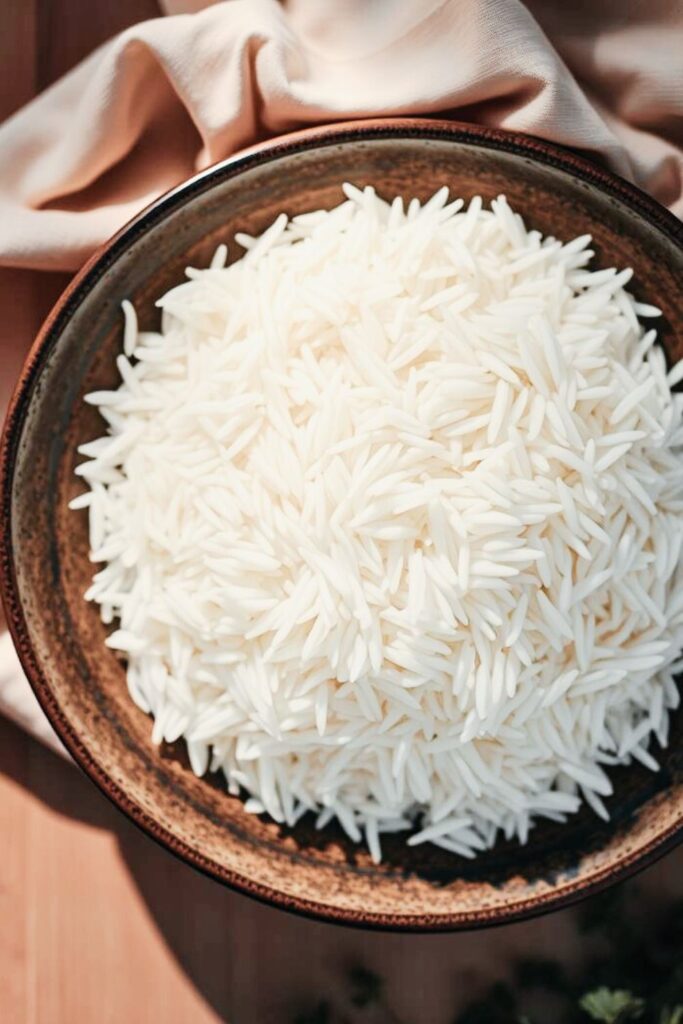Perfect Instant Pot Basmati Rice isn’t just a side, it’s a lifesaver on chaotic days. You’ve had those moments. The kitchen’s a mess, the clock’s racing, the kids want “real food,” and takeout feels like defeat. You scan the pantry and spot it: a humble bag of basmati rice. Familiar, yes. But can it be flawless, fast, and hands-free?
That was my Tuesday. No plan, no prep, just a craving for something warm, comforting, and effortless. I wasn’t reaching for a cookbook. I reached for my Instant Pot and that’s when the game changed. I adjusted the water, dialed in the timing, and let the pressure do its magic.
What came out? Pure rice perfection. Long-grain, fluffy, separate not a mushy spoonful in sight. It smelled lightly nutty, fluffed with a fork like a dream, and soaked up sauce like it was made for the spotlight.
This is the method. The Perfect Instant Pot Basmati Rice method. Easy steps, pro tips, and tweaks for when you want to dress it up. Because once you make it this way, you’ll never look back, and you’ll never babysit a pot again.
Why Basmati Rice Deserves Your Attention

Basmati isn’t just another long-grain rice. This aromatic beauty grows in the Himalayan foothills for centuries. Farmers developed its characteristic fragrance and delicate texture through generations of careful breeding. The name literally means “fragrant” in Hindi. Trust me, it lives up to that promise.
Producers age the best basmati for at least a year, sometimes two. This reduces moisture content and develops those complex flavors. Cook it properly and the grains elongate rather than plump up. This creates that distinctive fluffy texture.
The Instant Pot transforms this special grain into magic. The pressure cooking environment creates perfect steam circulation. This ensures even cooking from top to bottom. No more stirring, no burnt spots, no wondering if it’s done.
Ingredients & Smart Swaps
Here’s what you need, listed in the order you’ll actually use them:
- 1 cup basmati rice (preferably aged)
- 1 cup water
- 1/2 teaspoon salt
- 1 tablespoon ghee or butter (optional but recommended)
That’s it. Simple ingredients, extraordinary results.
Can’t Find Aged Basmati? Regular basmati works fine. You might notice slightly less fragrance though. Look for brands like Tilda, Royal, or Kohinoor when shopping for quality.
Ghee vs. Butter vs. Oil: Ghee gives the most authentic flavor. It prevents sticking beautifully. Butter works great too, adding richness. Coconut oil creates a subtle tropical note. Skip the fat entirely if you prefer. You’ll miss out on that silky texture though.
Salt Variations: Sea salt or kosher salt work perfectly. I’ve experimented with flavored salts too, try a pinch of black salt for an earthy twist, or herb salt for Mediterranean-inspired dishes.
Water Quality Matters: If your tap water tastes heavily chlorinated, consider filtered water. Strong chemical tastes can affect basmati’s subtle flavors.
Here’s a pro tip most people miss: basmati needs different water ratios. Other grains don’t follow the same rules. Basmati needs less water because it absorbs liquid differently. Too much water creates mushy rice. Too little leaves it undercooked and dry.
The Perfect Instant Pot Basmati Rice Method
Step 1: Rinse Until Clear
This step is non-negotiable. Place your basmati in a fine-mesh strainer. Rinse under cold water, swishing gently with your fingers. Keep rinsing until the water runs clear. This usually takes 3-4 rinses.
Why does this matter? You’re washing away excess starch. That starch would otherwise make your rice gummy. Those cloudy first rinses remove surface starch. This starch accumulated during processing and storage.
Step 2: Optional Soaking (But Worth It)
Here’s where I’ll suggest something that might seem unnecessary. Soak the rinsed rice for 15-30 minutes. I know, I know, the Instant Pot is about convenience. But this extra step transforms good rice into incredible rice.
Soaking allows the grains to absorb water gradually. This helps them cook more evenly. The result? Longer, more separate grains that look stunning on the plate. If you’re in a rush, skip it. The rice will still taste delicious.
Step 3: The Magic Ratio
Add the soaked (or just rinsed) rice to your Instant Pot. Pour in exactly 1 cup of water. Add the salt and ghee if using. Give it a gentle stir to distribute everything evenly.
This 1:1 ratio is the secret sauce. Most rice recipes call for more water, but basmati is different. The Instant Pot’s sealed environment means less evaporation, so you need less liquid than traditional methods.
Step 4: Pressure Cook Perfection
Secure the lid, making sure the valve is set to “sealing.” Select Manual/Pressure Cook on HIGH pressure for 4 minutes. Yes, just 4 minutes. The magic happens during the natural pressure release.
Once the cooking cycle completes, resist the urge to quick-release. Let the pressure naturally release for 10 minutes, then carefully turn the valve to “venting” to release any remaining pressure.
Step 5: The Fluff Factor
Open the lid carefully, there’ll be a lot of steam. Using a fork (never a spoon), gently fluff the rice from the bottom up. This prevents breaking the delicate grains while ensuring everything’s evenly mixed.
The rice should be perfectly tender, with each grain distinct and aromatic. If it seems slightly wet, let it sit with the lid off for a few minutes. The residual heat will finish the job.
Troubleshooting Common Issues

Rice Too Mushy? You probably used too much water or didn’t rinse enough starch away. Next time, be more aggressive with the rinsing and stick to the 1:1 ratio.
Grains Sticking Together? This usually means insufficient rinsing or stirring too vigorously after cooking. Gentle movements are key with basmati.
Rice Too Firm? Try adding an extra 2 tablespoons of water next time. Some brands absorb liquid differently, and altitude can affect cooking too.
Burnt Bottom? Make sure you’re using enough liquid and that nothing’s stuck to the bottom before pressure cooking. A thin layer of oil or ghee on the bottom helps prevent sticking.
Variations to Keep Things Interesting
Coconut Basmati
Replace half the water with coconut milk for a rich, tropical twist. Perfect with curry dishes or as a dessert rice with a sprinkle of cinnamon.
Saffron Luxury
Add a pinch of saffron threads to the water before cooking. The result is golden, aromatic rice that’s fit for special occasions.
Herb-Infused Rice
Toss in a few cardamom pods, a cinnamon stick, or a bay leaf before cooking. Remove them before serving for subtle spice notes.
Lemon Basmati
Add a tablespoon of lemon juice and some zest after cooking. Brightens up the entire dish and pairs beautifully with grilled meats.
The Science Behind Perfect Rice
Understanding what happens during pressure cooking helps you become a better cook. When you seal that Instant Pot, you’re creating an environment where water boils at a higher temperature than normal, around 240°F instead of 212°F.
This higher temperature cooks the rice faster and more evenly. The steam can’t escape, so it circulates around every grain, ensuring consistent results. The natural pressure release is crucial because it allows the rice to finish cooking gently in its own steam.
The starch in basmati behaves differently than other rice varieties. It has a lower amylose content, which means it’s less likely to become sticky when properly cooked. The aging process breaks down some proteins, which is why aged basmati has that distinctive texture and elongated grains.
Presentation That Wows
Great rice deserves great presentation. Fluff it gently with a fork before serving, creating height and volume. Garnish with fresh herbs like cilantro or mint for color contrast.
For special occasions, mold the rice in a small bowl, then invert it onto the plate for a professional dome shape. Sprinkle with toasted nuts or dried fruits for texture and visual appeal.
Wine Pairing: Basmati’s subtle nuttiness pairs beautifully with light whites like Pinot Grigio or Riesling. For red wine lovers, try a light Pinot Noir that won’t overpower the delicate rice flavors.
Perfect Companions: This rice shines alongside Indian curries, Mediterranean grilled meats, or Asian stir-fries. It’s also fantastic as a base for rice bowls or stuffed vegetables.
Making It Your Own
Once you’ve mastered the basic technique, experiment with different additions. Try cooking the rice in broth instead of water for deeper flavor. Add a bay leaf or cardamom pods for aromatic complexity.
For a protein boost, stir in some toasted nuts or seeds after cooking. Pine nuts, almonds, or pumpkin seeds all work beautifully.
Consider texture contrasts too. A handful of dried cranberries or chopped dates adds sweetness and chew that complements the fluffy rice perfectly.
Storage and Reheating Tips
Leftover Perfect Instant Pot Basmati Rice keeps beautifully in the refrigerator for up to 4 days. Store it in an airtight container once it’s completely cooled.
To reheat, add a tablespoon of water per cup of rice and microwave in 30-second intervals, fluffing between each heating. The steam will revive the texture without making it mushy.
For stovetop reheating, use a heavy-bottomed pan with a tight-fitting lid. Add a splash of water, cover, and heat gently over low heat until warmed through.
Why This Recipe Changes Everything
Mastering Perfect Instant Pot Basmati Rice isn’t just about making a side dish, it’s about building confidence in the kitchen. When you can consistently produce perfect rice, you’ve got the foundation for countless meals.
This technique works because it respects the grain’s natural properties while using modern technology to eliminate guesswork. The result is rice that’s restaurant-quality but achievable for home cooks of any skill level.
The beauty of this method lies in its reliability. Whether you’re cooking for a quiet dinner at home or entertaining a crowd, you can count on perfect results every time.
Final Thoughts and Pro Tips
Remember, great cooking isn’t about following rules blindly, it’s about understanding techniques and adapting them to your preferences. Start with this foundation, then make it your own.
Invest in quality basmati rice if you can. The difference between good and great rice is noticeable, especially with such a simple preparation. Store your rice in airtight containers away from light and heat to preserve its delicate fragrance.
Most importantly, don’t be afraid to experiment. Once you’ve nailed the basic technique, try different spices, liquids, and add-ins. That’s how you develop your personal cooking style and create dishes that reflect your taste.
The Instant Pot has revolutionized how we approach rice cooking, eliminating the guesswork and frustration that kept many people from attempting homemade rice. With this method in your repertoire, you’ll never have to settle for mediocre rice again.
Frequently Asked Questions
Can I double or triple this recipe?
Absolutely! The beauty of this method is its scalability. For larger batches, maintain the 1:1 ratio but increase the cooking time by 1-2 minutes. Natural pressure release becomes even more important with larger quantities.
What if my rice comes out too wet?
Let it sit with the lid off for 5-10 minutes after cooking. The residual heat will evaporate excess moisture. If this happens regularly, reduce the water by 2 tablespoons next time.
Can I use brown basmati rice with this method?
Brown basmati needs more time and liquid. Use a 1:1.25 ratio (rice to water) and cook for 15 minutes on high pressure. Everything else stays the same.
Why does my rice sometimes stick to the bottom?
Usually caused by insufficient liquid or residue from previous cooking. Make sure your pot is completely clean and consider adding a thin layer of oil to the bottom before adding rice.
How do I know if my basmati rice is good quality?
Look for long, unbroken grains with a consistent color. Quality basmati should have a subtle, nutty aroma even when dry. Aged varieties will have “aged” or the year on the package.

Swiftly Captions by Tina Smith — Quick, flavorful food recipes made simple, bringing fresh inspiration to your kitchen every day






